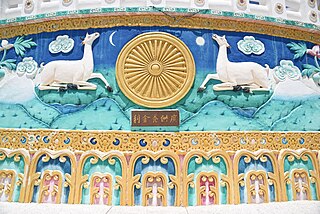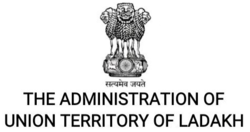
Ladakh is a region administered by India as a union territory and constitutes an eastern portion of the larger Kashmir region that has been the subject of a dispute between India and Pakistan since 1947 and India and China since 1959. Ladakh is bordered by the Tibet Autonomous Region to the east, the Indian state of Himachal Pradesh to the south, both the Indian-administered union territory of Jammu and Kashmir and the Pakistan-administered Gilgit-Baltistan to the west, and the southwest corner of Xinjiang across the Karakoram Pass in the far north. It extends from the Siachen Glacier in the Karakoram range to the north to the main Great Himalayas to the south. The eastern end, consisting of the uninhabited Aksai Chin plains, is claimed by the Indian Government as part of Ladakh, and has been under Chinese control since 1962.

Santosh Yadav is an Indian mountaineer. She is the first woman in the world to climb Mount Everest twice and the first woman to successfully climb Mount Everest from Kangshung Face. She climbed the peak first in May 1992 and again in May 1993 with an Indo-Nepalese Team.

Ladakh Buddhist Association (LBA) is an organization in Ladakh, India concerned with interests of Buddhists in Ladakh. It was founded in 1933 by King Jigmet Dadul Namgyal, Kalon Tsewang Rigzin, lachumir Munshi Sonam Tsewang and Kalon Bankapa Morup Gyaltsan

Major Hari Pal Singh Ahluwalia was an Indian mountaineer, author, social worker and Indian Ordnance Factories Service (IOFS) officer. During his career he made contributions in the fields of adventure, sports, environment, disability and social work. He is one of six Indian men and the twenty first man in the world to climb Mount Everest. On 29 May 1965, 12 years to the day from the first ascent of Mount Everest, he made the summit with the fourth and final successful attempt of the 1965 Indian Everest Expedition along with H. C. S. Rawat and Phu Dorjee Sherpa. This was the first time three climbers stood on the summit together.

Harish Chandra Singh Rawat was a mountaineer who climbed the Mt. Everest in 1965. He was one of the 9 summiters of the first successful Indian Everest Expeditions that climbed Mount Everest in May 1965 led by Captain M S Kohli. He is the seventh Indian man and twenty second man in world that climbed Mount Everest. On May 24, 1965 Vohra and Ang Kami Sherpa together reached the top of Mount Everest On May 29, 12 years to the day from the first ascent of Mount Everest the fourth and last summit team with Major H. P. S. Ahluwalia and Phu Dorjee Sherpa, Rawat reached on the summit. This was the first time three climbers stood on the summit together.

A union territory is a type of administrative division in the Republic of India. Unlike the states of India, which have their own governments, union territories are federal territories governed, in part or in whole, by the Union Government of India. There are currently eight union territories in India, namely, Andaman and Nicobar Islands, Chandigarh, Dadra and Nagar Haveli and Daman and Diu, Delhi, Jammu and Kashmir, Ladakh, Lakshadweep and Puducherry.
Wing Commander Nirupama Pandey is an Indian mountaineer. She is the first person from Bihar to have scaled Mount Everest on 25 May 2011 at 1015 hrs (IST). Nirupama was part of the first-ever all-woman IAF team comprising flight lieutenant Nivedita Choudhary and flight lieutenant Rajika Sharma.

Jonathan James Kedrowski is an author, ski-mountaineer, and geographer from Colorado. He is best known for summiting and camping overnight on the summit of all of Colorado's Fourteeners in 2011.
Love Raj Singh Dharmshaktu is an Indian mountaineer who has climbed Mount Everest seven times.

Sonam Wangyal is a former Indian paramilitary personnel and mountaineer who climbed Mount Everest in 1965 at the age 23, making him the youngest summiter. He was one of the nine summiters of the first successful Indian Everest Expeditions that climbed Mount Everest in May 1965 led by Captain M S Kohli,. He is the third Indian man, and eighteenth man in world, to have climbed Mount Everest. On 22 May 1965, the first time that the oldest and the youngest climbed Everest together.

Malavath Poorna is an Indian mountaineer. On 25 May 2014, Poorna climbed Mount Everest, aged 13 years and 11 months, the youngest Indian and youngest female to have reached the summit. Purna climbed Mount Elbrus, the highest peak in Russia and Europe on 27 July 2017. After reaching the summit of Elbrus, Poorna unfurled a 50 ft long Indian Tricolor and sang the Indian National Anthem. She completed the Seven Summits on 5 June 2022 climbing Mount Denali, along with father-daughter duo Ajeet Bajaj and Deeya Bajaj.

Harbhajan Singh is an Indian mountaineer, known for his successful mountaineering expeditions of Mount Everest, Mount Nanda Devi and many other peaks in the Himalayan region. The Government of India honored him in 2011, with the fourth highest civilian award of Padma Shri.
Aparna Kumar is an Indian mountaineer. She was awarded the Tenzing Norgay National Adventure Award in 2018 for land adventure by the President of India.

The Emblem of Jammu and Kashmir is an official symbol used to represent the government of Jammu and Kashmir, a region administered by India as a union territory.

Ladakh Police is the police agency responsible for law enforcement and investigations within the Union territory of Ladakh, India. It came into existence on 31 October 2019.

The Administration of Union Territory of Ladakh(sic) is the governing authority of the Indian union territory of Ladakh and its two districts. The Administration is led by a Lieutenant Governor appointed by the President of India who acts on behalf of the central Government of India. Ladakh does not have an elected legislative assembly. The two districts of Ladakh both elect their own autonomous district council-the Leh Autonomous Hill development council and the Kargil Autonomous Hill development Council, which have competence over a range of domestic affairs.

Politics of Ladakh is exercised within democratic setup of the Indian-administered union territory of Ladakh. Major power centres are Ladakh Autonomous Hill Development Council, Leh and Ladakh Autonomous Hill Development Council, Kargil alongside Ladakh Lok Sabha constituency. Indian National Congress and Bharatiya Janata Party are major political parties. Ladakhi religious organisations like Ladakh Buddhist Association, Imam Khomeni Memorial Trust and Anjuman-e-Jamiat-ul-Ulama Asna Asharia have major influences as well.















